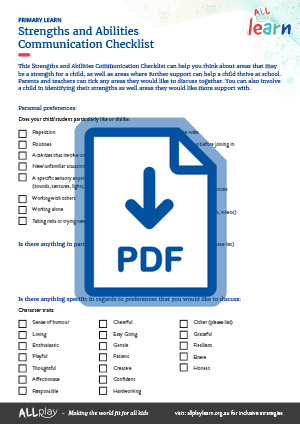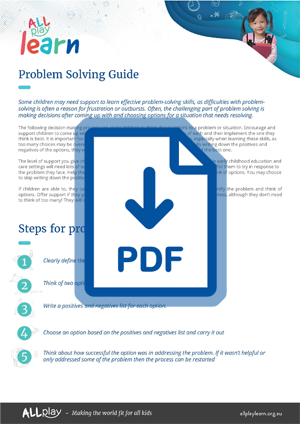
About autism
Every child with autism is different, there is no ‘one size fits all’. Children with autism typically have difficulties with socialising and communicating with others. Although they may have social difficulties they are often keen to join in, they just might not know how. Some children might have lots of language and others might only use a few words or no words.
Children with autism may follow routines and rules well as they tend to like things to be done in a particular way or order. They may have a favourite activity that they are happy to do over and over again, and they may need warning before switching between tasks. They may not participate in pretend play or in games with other children. Some children may find loud noises or particular sounds or textures uncomfortable. As every child with autism is different, educators can get to know each child’s unique likes and dislikes, to provide appropriate supports and ensure the early childhood education and care setting is inclusive.

Strengths
What might be some strengths?
- Some children may have good visual perceptual skills. They may be good at visual searches and visual recognition.
- Some may be good at recognising different sounds and music.
- Some children may be good at recognising patterns and solving problems.
- Children with a strong interest in a particular topic may have learned lots of information about that topic.
Where might you provide support?
- Some children with autism might not understand personal space and may stand too close to others. They might talk too loud or say things that don’t seem to fit. They may not make eye contact. This can make it hard for them to fit in socially.
- They might have difficulties expressing themselves or understanding the meaning of things said to them including instructions.
- They may find it harder to know when or how to join in activities with other children. They may keep to themselves if they’re not shown how to join in or play within a group.
- They tend to be less settled when plans are changed or they need to move between tasks when they are not warned about the change.
- They may be sensitive to certain sounds or other sensations, such as touching sand or mud.
- Some children may struggle with motor tasks such as writing or drawing.
- They may become easily overwhelmed and have ‘meltdowns’.

Evidence-based strategies
Structured learning experiences
Adapt activities to be as inclusive as possible
Provide positive feedback
Provide lots of practice opportunities
Provide opportunities to work with others
- Provide a visual schedule. Visual cues can let children know what is coming up, and how they should move from one activity to another.
- Have a consistent routine. Make the structure of each day similar but change tasks within the structure to keep the day interesting.
- Give a warning when a transition is coming up. Children who find moving from one activity to another hard will feel more settled if they are aware it is coming up. Provide clear instructions about the transition.
- Use structured play before free play. Children with autism are more likely to join in during free play if this follows structured play in the same setting in pairs or small groups.
- Add child interests into the learning process. Link activities to the child’s interests. For example, if a child is interested in bugs and you are making art allow them to draw or paint bugs.
- Include music and games in learning tasks. Children with autism may pay more attention and learn more when including music or simple games in the learning process.
- Give encouragement and guide learning. Consider providing positive feedback and correcting immediately when children are learning a task or behaviour. This can be gradually reduced as they become more capable.
- Encourage using interests. Some children may be highly motivated by their interests. Consider letting a child engage in activities related to their interest to acknowledge effort.
- Children may need to practise a task or behaviour many times. Time to practise in different settings and with different materials can help children learn to use that skill in other situations and places.
- Offer fewer tasks with more opportunities to practise. This helps children to learn tasks and may be more helpful than offering many tasks with little opportunity to practise.
- Help them with one to one attention. When a task is new, children usually learn best with help (i.e. prompts, demonstrations, encouragement). Help can be gradually reduced as they become more capable. Help can be provided by educators or other children.
- Provide lots of opportunities for children to play together. Children can get to know each other and build relationships through playing together. Children can also learn through watching others. Consider ways in which you can facilitate a child’s interactions with others in a group.
- Have children play imitation games. Children with autism can learn by imitating others. For example, children could take it in turns to act out a skill or behaviour that the rest of the group copies.

Best practice tips
Provide a safe space
Express positive regard and support
Allow the use of noise-reducing headphones
Support children to develop social behaviours
Minimise background noise and distractions while giving instructions
Ask parents how to help

Early Years Learning and Development Outcomes
Outcome 1: Children have a strong sense of identity
Outcome 2: Children are connected with and contribute to their world
Outcome 3: Children have a strong sense of wellbeing
Outcome 4: Children are confident and involved learners
Outcome 5: Children are effective communicators
- Educators can help children in developing their emerging autonomy, resilience and sense of agency through building an environment that helps children feel secure and safe.
- A consistent routine helps a child feel secure.
- Consider playing music that asks children to sit on the mat and greet peers. Some children will also need verbal prompts.
- Educators can help children with autism develop confident self-identities and the ability to interact to others with empathy and respect. For example, remind and prompt them to use positive behaviours and encourage or acknowledge effort.
- Educators can support active community participation in children with autism through including them in activities which link to their community such as excursions.
- Consider asking children to work in small groups or pairs to complete activities to build their connection to each other.
- Encourage children to play with each other and learn from each other by organising play imitation games.
- Verbal prompts or social cue cards can remind a child to approach other children to play or work together. Encourage or acknowledge these efforts.
- Songs which have actions that demonstrate social behaviour help a child to connect and play with others and understand social rules.
- Always look for opportunities to invite a child with autism to play with their peers or join a group activity.
- Help children learn to regulate their emotions by providing a safe space to calm down.
- A visual schedule and consistent routine can help children feel safe and contained.
- Providing one to one attention to learn new skills can help children feel supported and develop their sense of wellbeing through achievement.
- Reading with children with autism helps them learn. Questions about the story such as who/where/what questions or recall questions can support a deeper level of learning.
- Consider playing songs which show children how to do a planned activity. Songs such as “everybody washing hands” which show the actions and the order of those actions can help a child with autism follow instructions in a fun and engaging way.
- Consider playing a greeting song at the beginning of each session to give children time to practise saying hello to others.
- Ask children questions during activities. For example, ask them about a story that was read to them to encourage them to communicate.
- Consider using social cards to encourage manners or social behaviours. Social cards show pictures of a child communicating with another (e.g. waving goodbye, saying thank you).
- Look for opportunities to encourage children to communicate. You could ask them to make a choice or to tell you more about something they have said.

Other considerations
First aid
Safety drills
Behaviour
Toileting
Sleep
Relief educators
Transitions
Peer mediation
Other co-occurring conditions
- Giving first aid to a child with autism may be difficult if the child is sensitive to particular smells or textures. Some children may be distressed by blood or bandages or refuse to have an ice pack or medication.
- Talk to a child’s family to identify the best way to manage an injury/illness
- Children who don’t speak may have difficulty communicating that they are in pain or unwell. Watch for signs of pain such as grimacing and encourage gestures or other methods of communication to work out what may be happening.
- Some children may be under sensitive to pain. For example, they may hurt themselves and not notice or communicate it. Watch for signs that they might have hurt themselves.
- Unexpected safety drills may upset some children
- Consider letting the child know beforehand that there will be a drill
- Pair them with a buddy or safe person
- Noise-reducing headphones may help with the noise from the alarm
- Identifying the cause of a child’s behaviour can help both the educator and the child feel less frustrated
- Some common causes of challenging behaviour include difficulty in communicating their wants and needs, feeling stressed, sensory overload, trouble understanding or working on a task, or not understanding rules or expectations
- Encouragement and acknowledgement for positive behaviour may be helpful. Encouragement that is linked to children’s interests may be most effective.
- Refer to the ABC approach for more information on how to reduce challenging behaviour by supporting the child and promoting more helpful behaviour, and our emotions page for more information about supporting a child with managing their emotions.
- Some children with autism may find sleeping challenging
- Talk to caregivers about what can help a child sleep, such as a special toy or routine that they prefer
- A child with autism may find having a different educator and changed routine upsetting
- Informing relief educators of the specific routines and strategies that help that child may reduce distress
- A child with autism may need support when moving from the early childhood education and care setting to another setting (i.e. another early childhood education and care setting or primary school).
- See AllPlay Learn’s story A school day to help prepare children for the move
- For more information about supporting children with disabilities when transitioning to a different education setting, access AllPlay Learn's transition page.

Relevant resources
Visit our educator resources page for a range of resources that can help to create inclusive education environments for children with disabilities and developmental challenges. AllPlay Learn’s stories can help children with autism become familiar with the early childhood education and care setting and some of the skills they need to participate in these settings. Other relevant resources for children with autism are:





